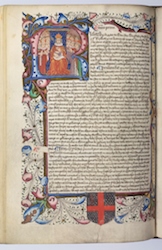The 1297 Magna Carta will spearhead the launch of the new City of London Heritage Gallery which opens to the public on Friday 12 September. Admission will be free to this permanent exhibition space which will showcase a rotating selection of rare, fascinating and sometimes surprising documents from the extensive archives of the City of London Corporation, at the heart of both London’s and the nation’s political and social history for over 1,000 years.

1297 Magna Carta (London Metropolitan Archives)
This new purpose-built exhibition space at the Guildhall Art Gallery is located in the heart of the City, next to the medieval Guildhall. The Guildhall Art Gallery itself houses and displays paintings and sculptures collected by the City of London Corporation including iconic Victorian paintings and fascinating scenes of London life from the 17th century to the present.
The new Heritage Gallery will be open daily and will feature items including Shakespeare’s purchase deed for a house in Blackfriars (1613) which carries his signature – one of only six known examples in the world. The Gallery will also look at the contribution made by London’s diverse communities, such as the Irish dockworkers and the arrival of African-Caribbean immigrants in the late 1940s, providing a ‘house of history’ for London past, present and the future.
Some of the other items on display at the new Heritage Gallery include:
1297 Magna Carta
With the 800th anniversary of the Magna Carta coming up in 2015, visitors will have the unique opportunity to see the finest surviving 13th century version in existence. Featuring what could be described as the world’s first ‘Post-It’ note – a superimposed memorandum which reads ‘Make it happen’ – this historic document reflects the central role of the City of London in implementing the charter.
London in World War One
To tie in with the centenary of the beginning of WWI, the exhibition will include also a poster for a recruitment meeting held at Guildhall in 1914, the first of many to take place throughout the country following the outbreak of war, at which the Lord Mayor proposed a resolution to support the national call to arms. Insights into how London changed in the first few months of the war can be seen in the Minutes of the London County Council’s Emergency Committee. Food prices and unemployment rose sharply with the rapid decline of trades such as tailoring and the manufacture of fine goods and, curiously, excessive drunkenness amongst women across the capital was reported.

World War 1 recruitment poster (London Metropolitan Archives)
Medieval City
Other exhibits on display include the medieval Cartae Antiquae. An essential reference tool for medieval City of London officials, this volume contains transcripts of charters and statutes covering laws enacted from 1327 to 1425, including in the reign of Richard III. The City of London Corporation also owns a set of paintings of all 25 City Aldermen who were in post in the mid-fifteenth century. These heraldic portraits show the dignity and standing of the office holders and give a fascinating glimpse of the men who governed the medieval City.

Cartae Antiquae (London Metropolitan Archives)
Back to top




